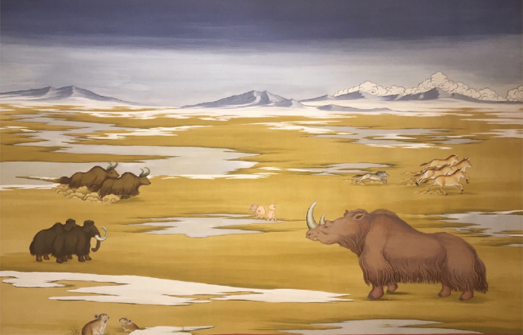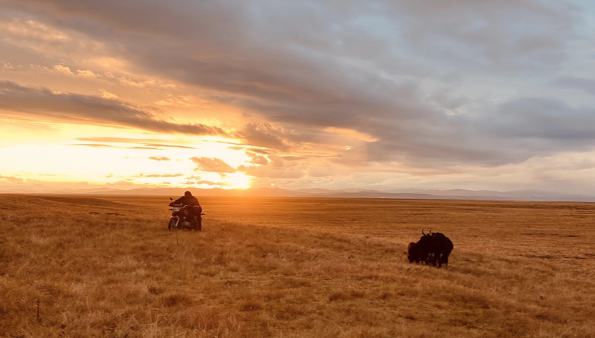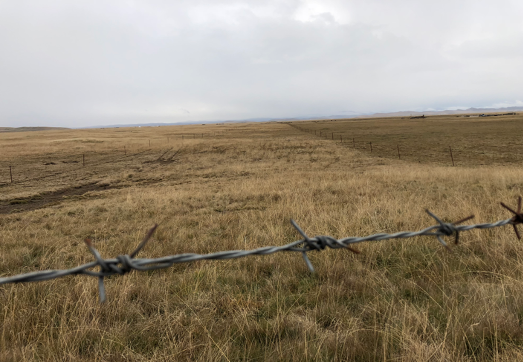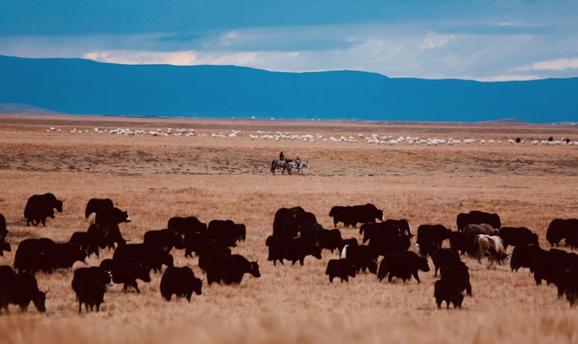“If people say we are lagging behind, then we are only lagging behind in destroying the earth.”
— Akhu Sonam Tashi
Our Golden Fatherland, Your Fragile Wasteland
Read the opening lines of any Chinese scientific publication or Chinese policy document on the Tibetan Plateau and you will likely see one (or all) of the following descriptors: harsh environment (环境恶劣), cold weather (气候寒冷), dry land (旱地), wasteland (荒地), and fragile ecology (生态脆弱). Where do these apocalyptic perceptions of Tibetan land come from? Moreover, are there any conceptual equivalents of these terms in the languages of the Tibetan Plateau’s original inhabitants: its indigenous pastoralists and farmers?
The Tibetan Plateau is often referred to as the “Water Tower of Asia,” a moniker earned through the region’s status as a water source for an estimated 1.4 billion people, a fifth of the world’s population across East, Southeast, and South Asia. The Tibetan Plateau also provides its indigenous residents with millions of acres of prime grazing land. Unlike the aforementioned outside characterizations of the region as dry and inhospitable, the Tibetan Plateau is, at its heart, a life-giving force.

Figure 1. From the Tibetan children’s book, The World and Beings of Kirti Khachuka (2019)
Ecological research suggests that the formation of a pastoralist environment in the Tibetan highlands began about 8,000 years ago (Miehe et al. 2008). According to indigenous origin stories, long ago, the Tibetan Plateau was occupied by rhinoceroses and elephants, as illustrated in the above painting. In 2020, paleontologists discovered bovid and rhinoceros species in Tibetan Plateau about 5,200 years ago (Ningbo Chen et al 2020). Unsurprisingly, subsequent publications on the discovery neglected to mention the prescience of ancestral knowledge and the indigenous creation myth. Our ancestral knowledge has become your scientific discovery.
In his galvanizing short story, The Valley of the Black Foxes (2012), the Tibetan writer Tsering Dondrup describes the fictional county of Tsezhung’s gushing springs, dense forests, and rich variety of plants and shrubs. Before Tsezhung is faced with the irreversible destruction brought about by a local mining project, its grasslands are covered with a diversity of blossoming flora: leopard plants, knotweed, lamiophlomis, white snow lotus, black and white gentians, Himalayan aster, Tibetan dandelions, white wormwood, potentilla, and countless other plants and flowers.
As a child growing up in a Tibetan pastoral community in the 1990s, one of my favorite games was to collect plants and flowers and compete with other children to identify our findings. The winner was usually able to name over fifty different species. Whenever the competition got intense, we would invite elders in our community to serve as impartial judges. When these judges found out that some kids had made up names for their flowers and plants in order to win, we would laugh together to no end. A Tibetan saying goes, “If you don’t know about something, ask an elder; if you can’t see far, go to the top of a mountain.” Back then, in our eyes, our elders were incredibly knowledgeable resources who formed the bedrock of our community. However, as I will go on to illustrate, our respect and reverence for our elders would dramatically wane after we began our schooling.
Tibetan poets often affectively describe the beings on the Tibetan plateau as living in closely-knit groups, feeding off of the beautiful rivers and plant life of this medicinal snow-land. The oft-cited Tibetan legend, The Epic of Gesar, says that this land is blessed with one thousand lotuses. Similarly, Tibetan pastoralists refer to their home as their golden fatherland (Tib. gser mdog gi pha sa), where the color gold, rather than green is associated with the vitality of the land.

Figure 2. Photograph by Yeshi Drakpa, 2020
You might think that I am overly romanticizing life on the Tibetan Plateau. But indigenous Tibetans are not so concerned with issues such as cold weather or having enough oxygen. The weather gets cold in the winter, sure, but it’s not so difficult if your body is ensconced in warm sheep-skin robes. Likewise, though a snowstorm might kill a large number of the animals you depend on for survival, a strong culture of mutual aid and resilience helps you cope with uncertainty in trying times. As one Tibetan elder in eastern Tibet recounted to me, “Apart from the collectivization period of the 1950s, someone dying of hunger or poverty was unheard of in the long history of our community.” More often than not, external assessments of the Tibetan Plateau that reference its “harsh environment,” “cold weather,” “dry land,” “wasteland,” and “fragile ecology” only serve to advance and justify the policies and interventions of the Chinese state in Tibet.
Erased Land
Since the Maoist years, the reframing of the Tibetan environment as the sovereign property of the Chinese state has been a process of erasing Tibetans’ affective and historical relationships to their ancestral land. Since the mid-1990s in particular, Tibetan pastoralists have been confronted with a mandatory rangeland fencing policy, which, through its use of barbed wire fence, has significantly altered traditional communal grazing customs through practices of dividing, quantifying, and bounding land in a new language of units, laws, and contracts (Bauer 2005). In the process, indigenous ways of conceptualizing the land are being erased from the landscape. Instead, the Tibetan-inhabited landscape is blanketed with state terminology and definitions of land today.

Figure 3. Patches of grassland fenced by barbed wire in Eastern Tibet. Photo by the author, 2019
Underpinning the rangeland fencing policy is the presumption that overgrazing leads to grassland degradation, a notion which draws upon dated assumptions from the Tragedy of the Commons (Hardin 1968)—namely, that common property, such as communal pasture use is not only damaging to the environment, but also deeply irrational. This imposed narrative of overgrazing has long been employed to justify a suite of top-down policies on the Tibetan Plateau which combine the free-market mechanism with advocacy for land privatization, “scientifically-guided” land management through rangeland fencing, and “green” development through the mass relocation of Tibetan nomads (Yeh 2009).
For Tibetans, land is ancestral territory, not wasteland or inert ground; it is profoundly local, social, and spiritual. Both the integrity and prosperity of Tibetan land are protected by territorial gods (Tib. yul lha) and mountain deities (Tib. gzhi bdag), who rule from the highest peaks and accept peoples’ daily offerings (Karmay 1998; Makley 2018). In this indigenous worldview, humans are not the owners of the land. Natural entities and landforms are instead inhabited and manned by empowered beings, such as the water-dwelling klu, or nagas, and other forces. Understanding the Tibetan environment requires an appreciation for the complexity of these indigenous belief systems, which are built on the foundations of interdependent relationships between people, their ancestral territory, mountain deities, and fortune-bearing animals (Tib. gyang ra sgo bzhi)—such as yaks, horses, sheep, and goats—all of which anchor the Tibetan pastoralists’ way of life.

Figure 4. Photograph by Yeshi Drakpa 2020
In thinking about the tangible impacts of external perceptions of the environment and people on the Tibetan psyche, even more consequential than land policies has been the Chinese state’s active inculcation of supposedly civil governance into the ordering of everyday life. In the following section, I hope to illuminate how the Chinese state lays the blame for economic marginalization, land degradation, and lack of human “quality” at the feet of “backward” Tibetan pastoralists.
The Political Installation of Human Inferiority
The rangeland fencing and resettlement policies seen on the Tibetan Plateau today were introduced to Tibetan pastoralists as a package that included the civilizing mission of educating and modernizing the nomads, to uplift their quality and value as human beings (Ch. suzhi). Since the 1990s, increasingly negative portrayals of Tibetan pastoralists have been employed in state development discourse to reinforce the deep-rooted mentality among government officials and urbanites alike that the lifestyle of Tibetan pastoralists is “backward” (Ch. luohou). Many scholars have focused on the impact of the development policies and discourses on the political economy of Tibetan pastoralists; here, I will briefly illustrate the corrosive impact of such policies and discourses on the minds of ordinary persons.
In 1997, the local government built a boarding school in my nomadic pastoral village. Based on a lottery, I was one of seven students recruited by the school for its inaugural class. Most families in the village were against sending their children to the school. As a result, they had to pay heavy monetary fines. The school itself only offered hot water and steamed bread for breakfast, lunch, and dinner. Thanks to our mother-like yaks, we grew up consuming yak yogurt, yak butter, and milk. The temperature in the sparse concrete building sank to below twenty degrees Fahrenheit (-7 Celsius) in the winter. All the students had cracks on their hands and feet; our cheeks were mostly red. The teachers instructed us in both Chinese and Tibetan.
Apart from teaching these subjects, the school had a larger mission: to alter our fundamental values and minds. Through interactions with our teachers—Tibetans from the lowland farming areas who had recently graduated from Chinese universities—we came to realize that our bodies were not “clean” enough, that our speech was not “civilized” enough, and that we had to seek out a “better” life. Anything could be done to mold us into this ideal modern subject. Beating was more than acceptable; thus, the pain was constant1. One’s freezing hands getting hit with a bamboo stick is truly the worst. As Tibetans say, “Pain may get old, but one never forgets it.”
“If you don’t want to lead the backward lives of your parents, study hard”; “If you don’t study hard, you will be nothing but a stupid nomad.” Our teachers drove us to hate our heritage, our elders, and even our parents. As embodiments of the state, they were there to plant the sense in us that a good life was on the outside, and not in our communities. They were there to punish us for being the children of Tibetan nomads. We felt ashamed of our cultural background; we developed an antipathy to our socio-cultural world itself.
You might be thinking that I use ‘we’ a lot in this essay as if all indigenous Tibetan pastoralists espouse the same values and beliefs. No contestations? No appropriations? No collaborations? My answer is yes to all of these but, as Kenyan writer and scholar Ngũgĩ wa Thiong’o powerfully states, when external pressures “annihilate a people’s belief in their names, in their languages, in their environment, in their heritage of struggle, in their unity, in their capacities, and ultimately in themselves” (1981, 3), the corrosive impacts of what I call the political installation of human inferiority are internally and viscerally felt and experienced by many, not just by a few.
‘People need to understand this. People will understand’
My later unexpected encounter with the English language in high school empowered me. I even found a voice in anthropology. In the summer of 2017, I conducted two years of fieldwork in a pastoral community in eastern Tibet for my doctoral dissertation. Although I presented myself to locals as a naïve anthropologist by asking them strange questions, the communities there welcomed me as a native son and shared their joys and pains with me.
What pained me the most during my research was the realization that many Tibetan pastoralists had internalized their externally-imposed inferiority. The Chinese state’s systematic efforts to belittle and delegitimize Tibetan pastoralists’ way of life manifested in their daily speech. Whenever they answered my questions, their responses were prefaced with self-deprecating expressions such as “Of course, as a nomad, I don’t have any knowledge and education.” Many indeed have stopped believing in themselves. They have also stopped believing in the pricelessness of their wisdom in relation to their land and world, and in endeavors such as identifying the names and relations of our precious plants and flowers.
Still, there are local people who are fundamentally challenging the narrative of Tibetan pastoralists’ cultural backwardness today. I will end with this quote from the resilient Akhu Sonam Tashi2, a visionary leader in his late seventies who organized against the mining and extraction occurring in his community:
“When you go out there, Huatse, I want you to tell this to the world. We Tibetan pastoralists are the original inhabitants of this place. We’ve lived on this land for thousands of years. We intend to live here many more years. It is hard to say that we have always protected this land, but we have never harmed it. These days, many say that we are the destroyers of this land in the name of overgrazing. How about mining? How about barbed wire fencing? Many also say we are backward. Isn’t today’s economic development also based on the foundation of environmental destruction? If people say we are lagging behind, then we are only lagging behind in destroying the earth. We are fine with that. You tell this to the world. People need to understand this. People will understand.”
Notes:
[1] I am not trying to say that beating students is a new invention in Tibetan society. In our case, violence was justified in the name of molding us into ideal modern subjects. We were made to feel grateful for receiving corporal punishment.
[2] Akhu Sonam Tashi is a pseudonym.
References:
Bauer, Kenneth. 2005. “Development and the Enclosure Movement in Pastoral Tibet since the 1980s.” Nomadic Peoples 19 (2).
Hardin, Garrett. 1968. ‘The Tragedy of the Commons’. Science NS 162 (3859): 1243-1248.
Karmay, Samten. 1998. The Arrow and the Spindle: Studies in History, Myths, Rituals and Beliefs in Tibet. Kathmandu: Mandal Book Point.
Makley, Charlene. 2018. The Battle for Fortune: State-led Development, Personhood, and Power among Tibetans in China. Ithaca, New York: Cornell University Press.
Miehe, Georg et al. 2009. “How Old Is Pastoralism in Tibet? An Ecological Approach to the Making of a Tibetan Landscape.” Palaeogeography, Palaeoclimatology, Palaeoecology 276 (1): 130–47.
Ningbo Chen, et al. 2020. “Ancient genomes reveal tropical bovid species in the Tibetan Plateau contributed to the prevalence of hunting game until the late Neolithic” PNAS November 10, 2020 117 (45) 28150-28159.
Thiong’o, Ngugi wa. 1986. Decolonising the Mind: The Politics of Language in African Literature. Oxford: James Currey Ltd / Heinemann.
Tsering Dondrup. 2017. The Valley of the Black Foxes (2012). Translated by Tenzin Dickie in Old Demons, New Deities: Twenty-One Short Stories from Tibet. OR Books. 2017.
Yeh, Emily. 2009. “Greening Western China: A Critical View,” Geoforum 40:884-894.
Cite as: Gyal, Huatse. 2021. “Our Indigenous Land is Not a Wasteland” American Ethnologist website, 6 February 2021, https://americanethnologist.org/features/reflections/our-indigenous-land-is-not-a-wasteland
Huatse Gyal is a Ph.D. candidate in anthropology at the University of Michigan. He is currently finishing his PhD thesis on how indigenous notions of place and legal languages of property interact, clash, and dovetail in the everyday cultural politics of land use in Amdo Tibet




